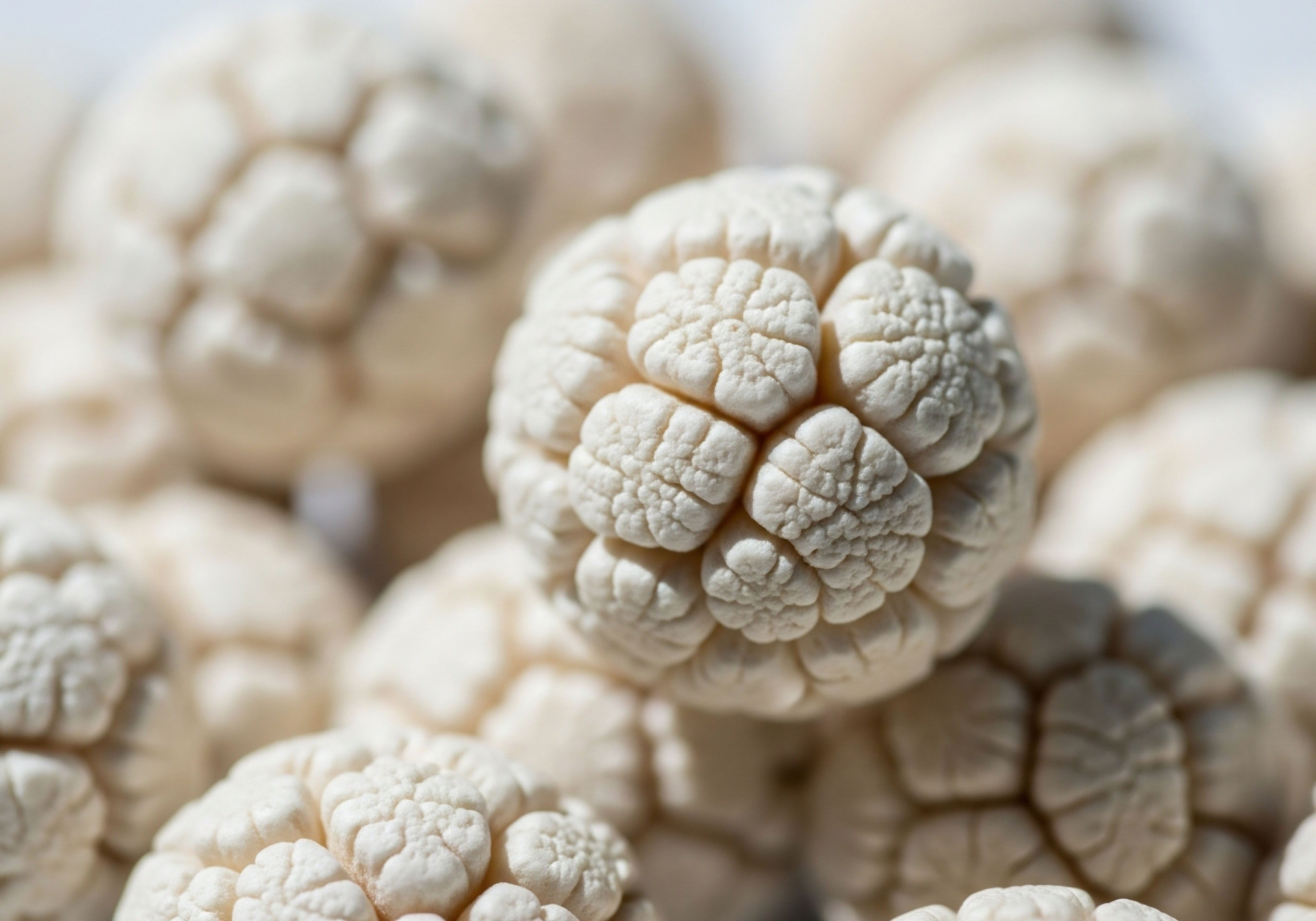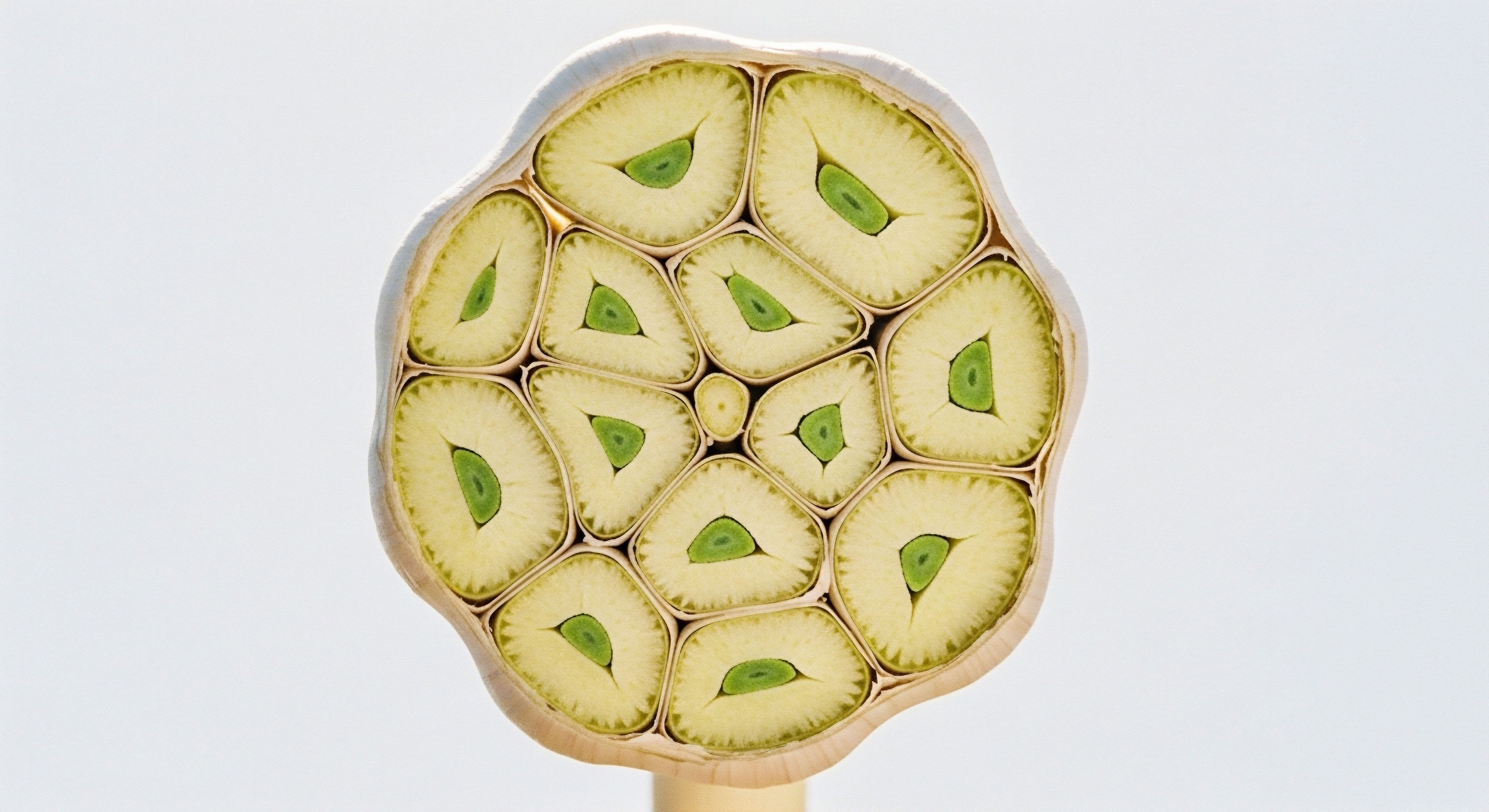

Fundamentals
Experiencing shifts in your vitality, perhaps a subtle decline in energy or a change in your physical composition, can prompt a deeper look into your body’s internal messaging systems. Many individuals exploring hormonal optimization protocols, such as testosterone replacement therapy, find themselves navigating a complex landscape of information.
A common concern that arises, particularly for men considering or undergoing such biochemical recalibration, centers on the impact on reproductive potential. This apprehension is valid and speaks to a fundamental aspect of well-being. Understanding your body’s intricate hormonal balance is the first step toward reclaiming function without compromise.
The body’s endocrine system operates through a series of interconnected feedback loops, much like a sophisticated thermostat system regulating temperature within a home. When exogenous testosterone is introduced, as in hormonal optimization protocols, the brain’s signaling to the testes can diminish. This occurs because the hypothalamus and pituitary gland, sensing adequate circulating testosterone, reduce their output of gonadotropins. This natural regulatory response is a primary reason why fertility considerations are paramount when discussing testosterone support.
At the core of male reproductive function lies the hypothalamic-pituitary-gonadal (HPG) axis. This axis is a delicate communication network involving three key components ∞ the hypothalamus in the brain, the pituitary gland situated below it, and the gonads, or testes, in men. The hypothalamus releases gonadotropin-releasing hormone (GnRH) in a pulsatile manner. This signal prompts the pituitary gland to secrete two vital hormones ∞ luteinizing hormone (LH) and follicle-stimulating hormone (FSH).
LH acts directly on the Leydig cells within the testes, stimulating them to produce testosterone. FSH, conversely, targets the Sertoli cells, which are crucial for supporting the development and maturation of sperm cells, a process known as spermatogenesis. When external testosterone is administered, the body perceives a surplus, leading to a reduction in GnRH, LH, and FSH production.
This suppression, while effective in raising systemic testosterone levels, can inadvertently reduce the internal testicular testosterone concentrations required for robust sperm production, thereby affecting fertility.
Understanding the HPG axis is essential for comprehending how hormonal interventions influence reproductive capacity.
For individuals embarking on a personal journey to optimize their hormonal health, recognizing the potential for this suppression is not a deterrent, but rather an invitation to approach treatment with informed precision. The goal is to support overall vitality while safeguarding reproductive goals. This requires careful monitoring of specific hormonal biomarkers, allowing for adjustments to the protocol that can mitigate unwanted effects on fertility.

Recognizing Hormonal Imbalance
Symptoms that might lead someone to consider hormonal optimization often include persistent fatigue, reduced physical stamina, changes in mood, or a diminished drive. These experiences can be disorienting, signaling that something within the body’s intricate systems is out of balance. When these symptoms align with lower-than-optimal testosterone levels, a discussion about hormonal support naturally arises. However, for men of reproductive age, the conversation must extend beyond symptom resolution to include the preservation of fertility.

Initial Considerations for Reproductive Health
Before initiating any form of hormonal support, a comprehensive assessment of reproductive health is a foundational step. This involves not only evaluating current hormonal status but also discussing future family planning aspirations. A baseline semen analysis provides a snapshot of sperm count, motility, and morphology, offering a critical reference point. This initial evaluation helps to identify any pre-existing conditions that might influence fertility, allowing for a more tailored and proactive approach to hormonal management.


Intermediate
Navigating the complexities of hormonal optimization while preserving fertility requires a precise understanding of clinical protocols and the specific agents employed. When testosterone replacement therapy is initiated, the body’s natural production of testosterone and sperm is often suppressed due to the negative feedback on the HPG axis. To counteract this effect and maintain reproductive potential, ancillary medications are frequently integrated into the treatment plan. These agents work by modulating different points within the endocrine system, aiming to sustain testicular function.

Protocols for Fertility Preservation during Hormonal Optimization
The standard protocol for male hormone optimization often involves weekly intramuscular injections of Testosterone Cypionate. When fertility is a consideration, this is typically combined with additional medications designed to support endogenous testosterone production and spermatogenesis.
- Gonadorelin ∞ This synthetic form of GnRH is administered via subcutaneous injections, typically twice weekly. Its purpose is to stimulate the pituitary gland to release LH and FSH in a pulsatile fashion, mimicking the body’s natural rhythm. This stimulation helps to maintain testicular size and function, including sperm production.
- Human Chorionic Gonadotropin (hCG) ∞ Often used as an alternative or in conjunction with Gonadorelin, hCG mimics the action of LH, directly stimulating the Leydig cells in the testes to produce testosterone. This helps to preserve intratesticular testosterone levels, which are essential for spermatogenesis, even while exogenous testosterone is being administered.
- Anastrozole ∞ This oral tablet, taken twice weekly, functions as an aromatase inhibitor. Its role is to block the conversion of testosterone into estrogen. While estrogen is vital for various bodily functions, excessive levels can further suppress the HPG axis and negatively impact sperm quality. By managing estrogen levels, Anastrozole helps to optimize the hormonal environment for fertility.
- Selective Estrogen Receptor Modulators (SERMs) ∞ Medications such as Clomiphene and Tamoxifen may be included, particularly in post-TRT or fertility-stimulating protocols. These agents block estrogen receptors, primarily at the hypothalamus and pituitary, thereby reducing estrogen’s negative feedback. This leads to an increase in endogenous LH and FSH secretion, which in turn stimulates testicular testosterone production and spermatogenesis.
Strategic use of ancillary medications can mitigate the fertility-suppressing effects of exogenous testosterone.
The selection and dosing of these medications are highly individualized, depending on the patient’s specific hormonal profile, fertility goals, and response to treatment. Regular monitoring of key biomarkers is paramount to ensure the protocol is effective and well-tolerated.

Essential Hormonal Biomarkers for Monitoring Fertility
Monitoring fertility during hormonal optimization protocols involves a panel of specific biomarkers that provide insights into the function of the HPG axis and testicular health. These measurements help clinicians assess the impact of therapy and make informed adjustments.
| Biomarker | Role in Fertility | Monitoring Purpose During TRT |
|---|---|---|
| Total Testosterone | Primary male androgen, essential for virilization and overall well-being. | Ensuring therapeutic levels are achieved while assessing the degree of HPG axis suppression. |
| Luteinizing Hormone (LH) | Stimulates Leydig cells to produce testosterone. | Indicator of pituitary stimulation and endogenous testosterone production; suppressed by exogenous testosterone. |
| Follicle-Stimulating Hormone (FSH) | Acts on Sertoli cells to support spermatogenesis. | Indicator of pituitary stimulation and Sertoli cell function; suppressed by exogenous testosterone. |
| Estradiol (E2) | Converted from testosterone; high levels can suppress HPG axis and affect sperm. | Monitoring for excessive aromatization and guiding Anastrozole dosing. |
| Semen Analysis | Evaluates sperm count, motility, and morphology. | Direct measure of spermatogenesis and overall reproductive potential. |
| 17-Hydroxyprogesterone (17-OHP) | A potential surrogate marker for intratesticular testosterone. | Assessing testicular steroidogenesis, particularly when direct intratesticular measurements are impractical. |
Regular assessment of these biomarkers allows for a dynamic approach to treatment. For instance, if LH and FSH levels remain significantly suppressed despite the use of Gonadorelin or hCG, adjustments to dosing or the inclusion of additional agents might be considered. Similarly, if semen analysis reveals a decline in sperm parameters, the protocol can be modified to prioritize fertility support.

How Do Ancillary Medications Influence Biomarkers?
Each ancillary medication exerts a specific influence on the hormonal milieu. Gonadorelin and hCG directly stimulate the testes, aiming to maintain LH and FSH levels, or their functional equivalents, to support spermatogenesis. Anastrozole reduces estrogen, which can indirectly lead to a slight increase in gonadotropins by lessening negative feedback, thereby improving the testosterone-to-estradiol ratio.
Clomiphene and Tamoxifen directly block estrogen receptors at the pituitary and hypothalamus, resulting in increased LH and FSH secretion, which then stimulates endogenous testosterone and sperm production.
The interplay of these agents is designed to create an environment where the benefits of hormonal optimization can be realized without sacrificing the capacity for reproduction. This delicate balance underscores the importance of ongoing clinical oversight and patient engagement in their health journey.


Academic
The academic exploration of fertility preservation during testosterone replacement therapy delves into the intricate molecular and cellular mechanisms governing the male reproductive system. Understanding the precise interplay of biological axes, metabolic pathways, and hormonal feedback loops provides a deeper appreciation for the challenges and strategies involved in maintaining spermatogenesis while optimizing systemic androgen levels. The central challenge lies in the inherent contraceptive effect of exogenous testosterone, which profoundly impacts the HPG axis.

The Endocrine Orchestration of Spermatogenesis
Spermatogenesis is a highly coordinated biological process occurring within the seminiferous tubules of the testes, requiring specific hormonal signals for its initiation and maintenance. The Leydig cells, located in the interstitial tissue of the testes, produce testosterone under the direct influence of LH.
This locally produced intratesticular testosterone (ITT) is present at concentrations significantly higher than circulating levels and is absolutely essential for the progression of spermatogenesis. Simultaneously, FSH acts on the Sertoli cells, which provide structural and nutritional support to developing germ cells.
When exogenous testosterone is introduced, the negative feedback mechanism on the hypothalamus and pituitary gland leads to a marked suppression of GnRH, LH, and FSH secretion. This suppression, in turn, reduces the stimulation of Leydig cells, leading to a precipitous drop in ITT. While systemic testosterone levels may be optimized, the crucial local testicular environment becomes deficient in the high concentrations of androgen necessary for robust sperm production, resulting in oligozoospermia (low sperm count) or even azoospermia (absence of sperm).
Maintaining high intratesticular testosterone is a key challenge when exogenous testosterone is administered.
The duration of testosterone therapy and the individual’s age can influence the time required for spermatogenesis recovery after cessation of exogenous testosterone. Older individuals and those with longer durations of therapy may experience prolonged recovery periods. This highlights the importance of proactive fertility preservation strategies rather than relying solely on post-therapy recovery.

Advanced Biomarkers and Their Clinical Utility
Beyond the foundational hormones, a deeper dive into specific biomarkers offers more granular insights into testicular function and the efficacy of fertility-preserving interventions.
| Biomarker | Clinical Significance | Relevance to TRT and Fertility |
|---|---|---|
| Inhibin B | Produced by Sertoli cells; reflects Sertoli cell function and spermatogenesis. | Decreased levels can indicate impaired spermatogenesis or Sertoli cell damage, often seen with HPG axis suppression. |
| Anti-Müllerian Hormone (AMH) | Produced by Sertoli cells in prepubertal males; less direct utility in adult male fertility. | Primarily used in female fertility, but its presence in adult males can sometimes correlate with Sertoli cell health, though not a primary fertility marker during TRT. |
| Sperm DNA Fragmentation Index (DFI) | Measures the integrity of sperm DNA. | Elevated DFI can indicate poorer sperm quality and reduced fertilization potential, potentially influenced by hormonal imbalances or oxidative stress during TRT. |
| Intratesticular Testosterone (ITT) | Direct measure of testosterone within the testes, crucial for spermatogenesis. | Direct measurement is invasive; 17-OHP serves as a surrogate marker. Maintaining ITT is the goal of ancillary therapies like hCG. |
The measurement of 17-hydroxyprogesterone (17-OHP) has emerged as a promising non-invasive surrogate marker for ITT. Studies indicate that serum 17-OHP levels are significantly reduced in men receiving exogenous testosterone, correlating with suppressed ITT. Conversely, treatments that stimulate endogenous testosterone production, such as hCG or clomiphene citrate, lead to an increase in 17-OHP, suggesting its utility in monitoring the effectiveness of fertility-preserving interventions.

Pharmacological Interventions and Their Mechanisms
The strategic deployment of pharmacological agents aims to circumvent the negative feedback imposed by exogenous testosterone.
- Gonadorelin (GnRH Analogues) ∞ Pulsatile administration of Gonadorelin directly stimulates the pituitary to release LH and FSH, thereby reactivating the HPG axis. This approach aims to restore the physiological signaling cascade necessary for testicular function and spermatogenesis. Research indicates that pulsatile GnRH therapy can induce spermatogenesis, sometimes more rapidly than cyclical gonadotropin therapy in specific hypogonadal conditions.
- Human Chorionic Gonadotropin (hCG) ∞ Functionally, hCG acts as an LH analog, binding to LH receptors on Leydig cells. This direct stimulation maintains ITT production, which is critical for supporting spermatogenesis even in the presence of exogenous testosterone. The half-life of hCG is significantly longer than natural LH, allowing for less frequent administration while still providing sustained Leydig cell stimulation.
- Aromatase Inhibitors (AIs) like Anastrozole ∞ AIs prevent the conversion of testosterone to estradiol by inhibiting the aromatase enzyme. While estrogen is essential, excessive levels can exert negative feedback on the HPG axis, further suppressing gonadotropin release. By reducing estrogen, AIs can indirectly support LH and FSH secretion and improve the testosterone-to-estradiol ratio, which is beneficial for spermatogenesis.
- Selective Estrogen Receptor Modulators (SERMs) like Clomiphene and Tamoxifen ∞ These compounds act as estrogen receptor antagonists in specific tissues, particularly the hypothalamus and pituitary. By blocking estrogen’s negative feedback at these sites, SERMs lead to an increase in endogenous GnRH, LH, and FSH secretion. This surge in gonadotropins then stimulates Leydig cell testosterone production and Sertoli cell function, thereby promoting spermatogenesis. Clomiphene, for instance, has been shown to increase serum testosterone, LH, and FSH levels, improving sperm parameters in men with hypogonadism.

Complexities and Future Directions
The response to these interventions can vary significantly among individuals, influenced by factors such as baseline testicular function, duration of prior testosterone exposure, and genetic predispositions. Some men may experience rapid recovery of spermatogenesis, while others may require prolonged therapy or may not fully regain their baseline fertility.
Ongoing research continues to refine these protocols and explore novel agents that can more effectively uncouple the benefits of systemic testosterone optimization from its suppressive effects on fertility. The ultimate goal remains to provide personalized wellness protocols that allow individuals to achieve their health objectives, including reproductive aspirations, with precision and confidence. This continuous scientific inquiry ensures that clinical practice evolves, offering increasingly sophisticated solutions for complex physiological challenges.

References
- Patel, A. S. Leong, J. Y. Ramos, L. & Ramasamy, R. (2019). Testosterone Is a Contraceptive and Should Not Be Used in Men Who Desire Fertility. World Journal of Men’s Health, 37 (1), 45 ∞ 54.
- Coviello, A. D. Matsumoto, A. M. Bremner, W. J. Herbst, K. L. Amory, J. K. Anawalt, B. D. et al. (2005). Low-dose human chorionic gonadotropin maintains intratesticular testosterone in normal men with testosterone-induced gonadotropin suppression. The Journal of Clinical Endocrinology & Metabolism, 90 (5), 2595 ∞ 2602.
- Lundy, S. D. & Trost, L. W. (2023). Study Suggests Broader Use of Anastrozole for Male Infertility. Consult QD, Cleveland Clinic.
- Mima, M. et al. (2025). Efficacy of clomiphene citrate and tamoxifen on pregnancy rates in idiopathic male subfertility ∞ A systematic review and meta-analysis. Asian Journal of Urology, 12 (1), 15 ∞ 22.
- Liao, S. et al. (2018). The Pulsatile Gonadorelin Pump Induces Earlier Spermatogenesis Than Cyclical Gonadotropin Therapy in Congenital Hypogonadotropic Hypogonadism Men. American Journal of Men’s Health, 12 (6), 1980-1987.
- Ramasamy, R. et al. (2014). Is semen analysis necessary prior to the commencement of testosterone supplementation therapy in men of reproductive age? Canadian Urological Association Journal, 8 (11-12), E893-E896.
- Ramesh Babu, S. Sadhnani, M. D. Swarna, M. Padmavathi, P. & Reddy, P. P. (2011). Evaluation of FSH, LH and testosterone levels in different subgroups of infertile males. Journal of Clinical and Diagnostic Research, 5 (5), 975-979.
- Bang, A. K. et al. (2017). Dynamic GnRH and hCG Testing ∞ Establishment of New Diagnostic Reference Levels. European Journal of Endocrinology, 176 (4), 350 ∞ 357.
- Sidhom, A. et al. (2022). Understanding and managing the suppression of spermatogenesis caused by testosterone replacement therapy (TRT) and anabolic-androgenic steroids (AAS). Therapeutic Advances in Urology, 14, 17562872221107560.
- Lundy, S. D. & Trost, L. W. (2023). Combination clomiphene citrate and anastrozole duotherapy improves semen parameters in a multi-institutional, retrospective cohort of infertile men. Translational Andrology and Urology, 12 (2), 253-260.

Reflection
Your personal health journey is a unique exploration, a continuous process of understanding and adapting. The insights shared here regarding hormonal biomarkers and fertility during testosterone optimization protocols are not merely clinical data points; they represent pathways to greater self-awareness and informed decision-making.
Recognizing the intricate dance of your endocrine system empowers you to engage proactively with your well-being. This knowledge serves as a foundation, a starting point for conversations with your healthcare provider, allowing for the creation of a truly personalized protocol. Your vitality and reproductive goals are intertwined, and with precise monitoring and tailored interventions, achieving both is within reach.



